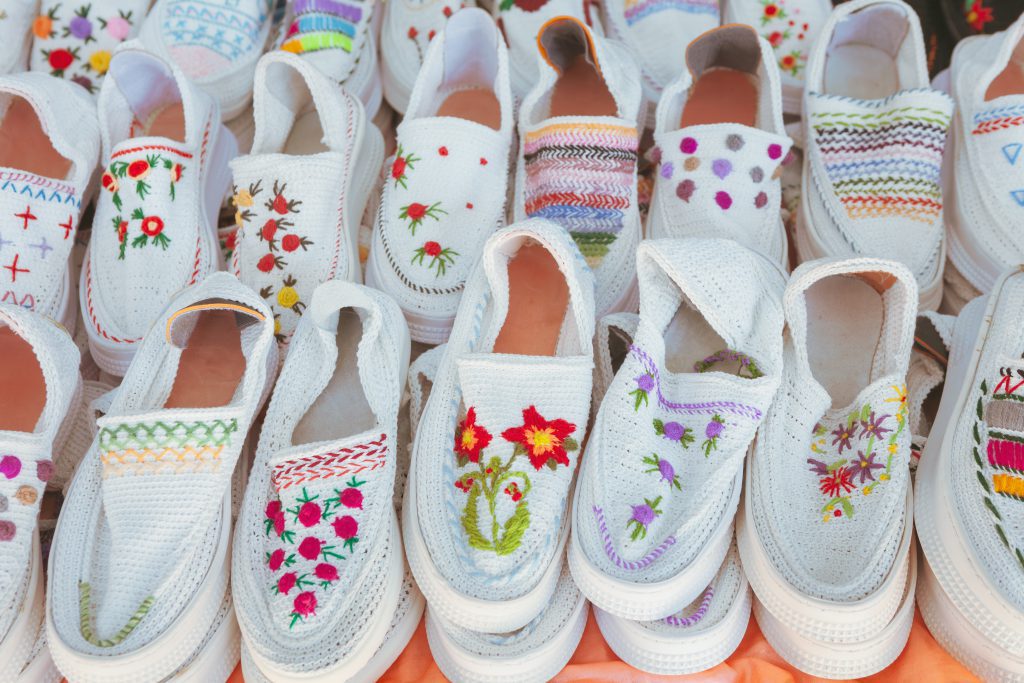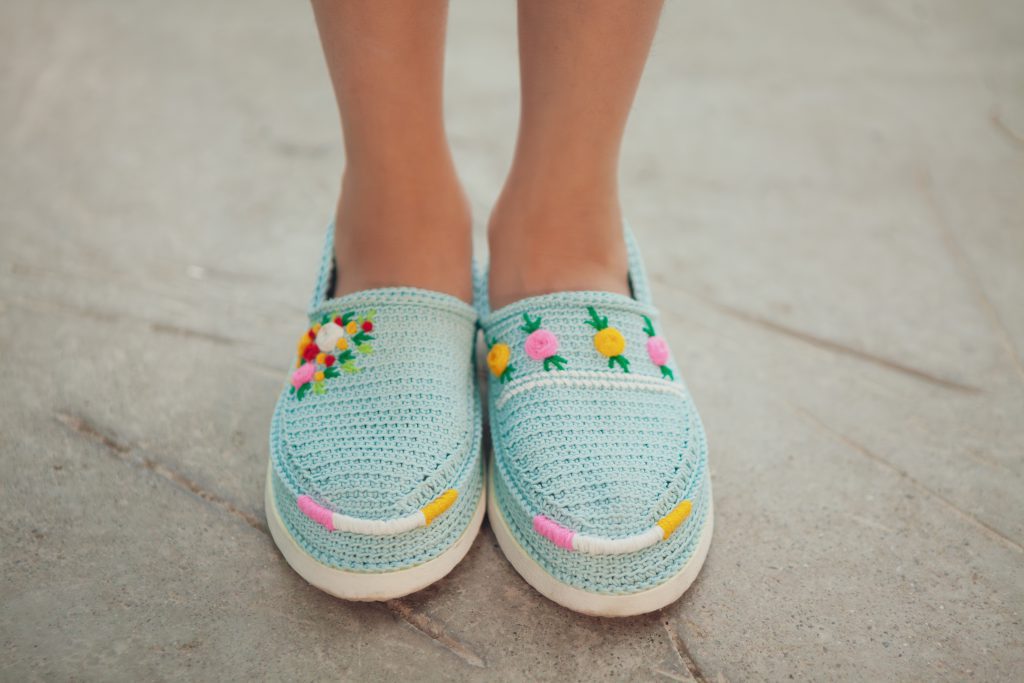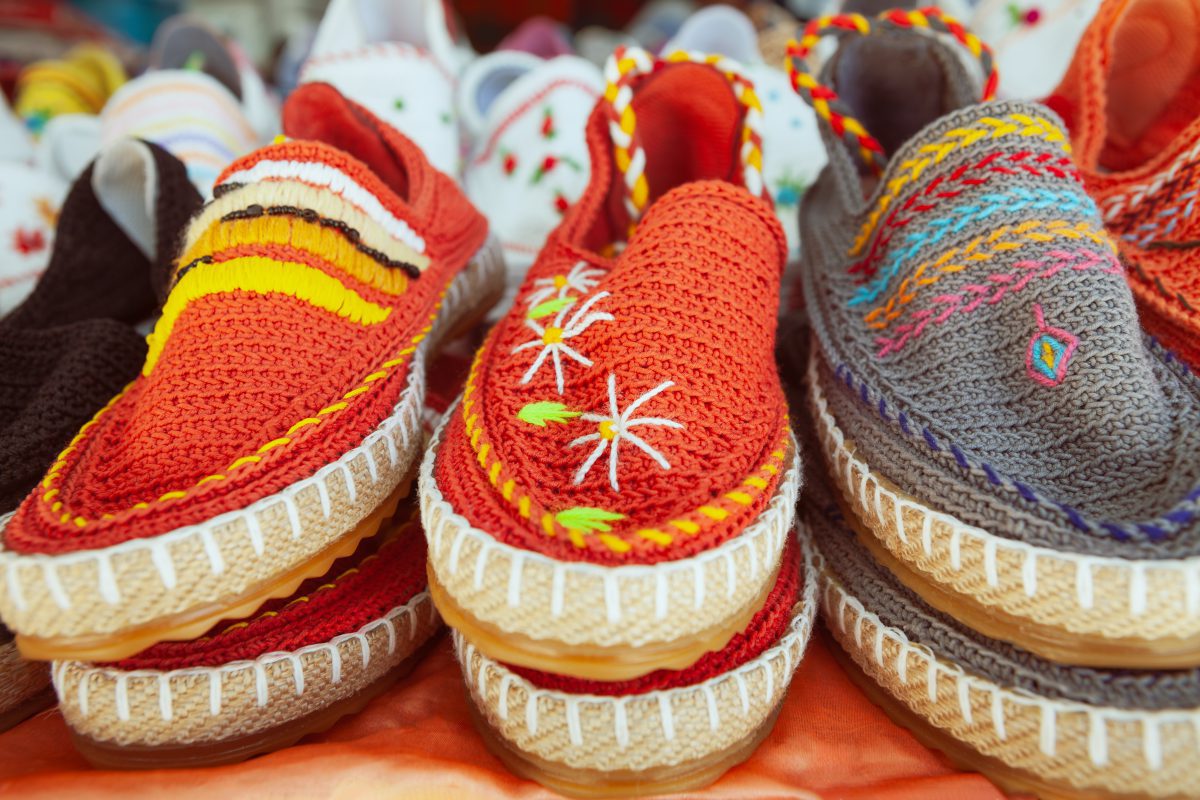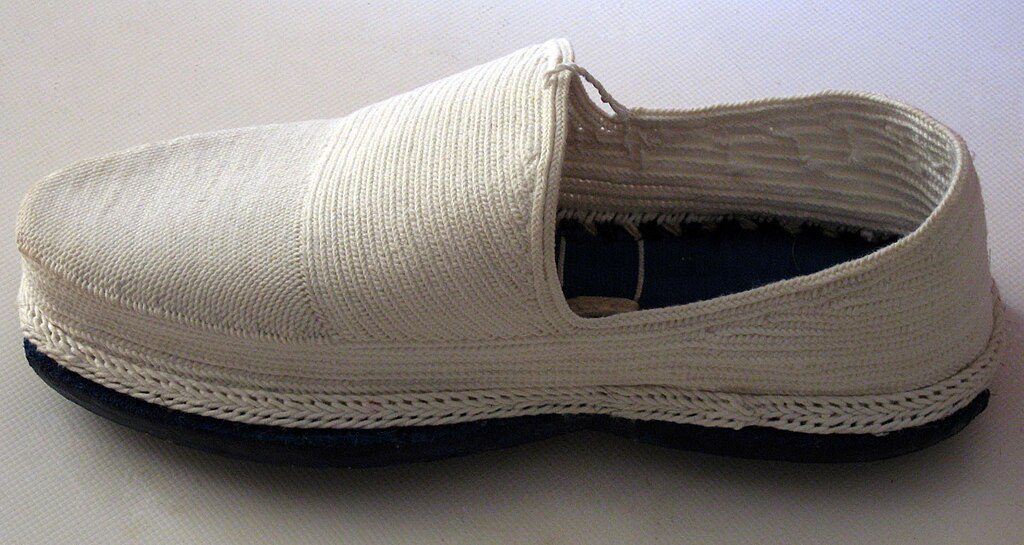Table of Contents
Giveh shoes, a remarkable piece of Iranian heritage, embody a rich blend of tradition and craftsmanship. Once a staple for men during the hot summer months, these clogs are not just footwear but a symbol of cultural identity. Crafted with a unique sole made from durable materials like leather or rubber, the upper part showcases exquisite artistry, often made from cotton or silk. The intricate designs reflect the skill and dedication of local artisans, who have preserved the age-old techniques of making these shoes.
In the Tati region, Giveh takes on the name “Jiveh,” highlighting its regional significance. The creation of this traditional footwear involves a collaborative effort, where women spin and weave the cotton threads, while men meticulously sew the soles. This communal approach to craftsmanship is steeped in tradition, with the upper portion often made using Nalbinding—a technique that predates both knitting and crochet. This not only adds a distinctive texture but also connects the shoes to a lineage of artisanal practices that have withstood the test of time.
History of Giveh Shoes
The evolution of Giveh shoes is deeply intertwined with the practical needs of the Iranian people throughout history. From ancient times, clothing and footwear served not only as protection against environmental elements like heat and cold but also as a reflection of cultural identity. Artworks and historical records reveal that clothing styles have undergone significant changes, mirroring the dynamic nature of Iranian society. The need for comfortable, lightweight, and affordable footwear became especially crucial for nomads and rural communities, facilitating their active lifestyles in a landscape dominated by agriculture and animal husbandry.
The roots of Giveh stretch back to ancient craftsmanship, with references to its weaving and production found in works by historians like Al-Balkhi. By the 14th century, regions like Ghandijan in Fars were renowned for their weaving industry, showcasing the expertise and artistry of local artisans. Despite its historical prominence, the rise of modern footwear has overshadowed this ancient footwear in recent years, leading to a decline in its traditional status. However, in areas like Qazvin, the legacy continues as skilled craftsmen keep the art of Giveh-making alive, maintaining the connection to a rich cultural heritage that has been cherished for generations.
How to Make Giveh Shoes
Raw Materials Required
- Materials for the top: Cotton threads (silk for higher-end versions)
- Materials for the soles: Leather, canvas, or modern plastic soles
Tools Required
· Special needle
· Hook (in some cases)
The Process of Crafting Giveh Shoes
- Prepare cotton or silk threads for weaving.
- Begin weaving the top using a needle or hook (“Tavane”).
- Start with a few loops at the top and expand row by row.
- Weave the heel in a circular shape.
- Complete the top, forming a sock-like piece.
- The weaving process takes about two days using medium-thickness yarn.
- In some regions, add geometric patterns with small holes for decoration.
Different Types of Giveh Shoes

Iranian Giveh shoes come in a variety of styles, each with unique features. Here are some of the most notable types:
- Maleki Giveh:
- Finely knit upper piece, making it more expensive.
- Longer toe cap and leather backing on the counter.
- Sole made from cotton and hemp canvas, woven together.
- Ajideh Giveh:
- Coarsely woven upper piece.
- Leather sole with straight stitching.
- Leather Sole Giveh:
- Resembles conventional shoes.
- Sole made of leather, popular among city dwellers (also known as City Giveh).
- Latte Giveh:
- Sole made from old cloth or canvas.
- Named “latte,” meaning old cloth in ancient Persian.
- Rubber Sole Giveh:
- More affordable option.
- Coarsely woven upper piece with a rubber sole.
- Silk Giveh:
- Finely woven upper made from colorful silk threads, often with embroidery.
- Sole made of leather or rubber, suitable for decorative purposes.
- Kurdish Giveh (Klash):
- Specific to the Kurdish regions of Iran, particularly Uraman.
- Lightweight and flexible, with a cotton upper and concentrated cloth sole, ideal for mountainous terrain.
Each type of Giveh showcases a blend of practicality and cultural heritage, making them a cherished part of Iranian tradition.
Colors and Patterns of Giveh Shoes

The color palette of Iranian Giveh shoes is both elegant and traditional, often showcasing a primarily white aesthetic, particularly in men’s designs. White cotton thread is commonly used, giving these shoes a classic and clean appearance. In regions like Qazvin, many woven types are simple and unadorned, focusing on the quality of craftsmanship rather than intricate patterns. However, in areas like the village of Ek in Takestan, creativity flourishes, with artisans experimenting with a variety of threads, including black and colorful silk, enriching the visual appeal of their creations.
Women’s Givehs often feature a vibrant mix of colors, incorporating decorative elements such as beads to create more intricate designs. This shift towards more colorful and personalized footwear reflects a broader trend in Giveh weaving, where artists are embracing innovation while honoring traditional methods. Notable artisans like Master Izatullah Taherkhani and Khanum Hourieh have contributed significantly to this evolution, ensuring that the art of Giveh weaving continues to thrive and adapt, resulting in a delightful array of styles that cater to diverse tastes.
Where to Buy Giveh Shoes
One of the best places to find these treasures is in the heart of Iran’s historic cities. In Isfahan, the Aligholi Khan Bazaar is a renowned hub for Giveh enthusiasts, where skilled artisans showcase their creations. This bustling market is where craftsmanship meets tradition, with local artisans proudly displaying their handmade footwear. Each pair of Giveh tells a story of cultural heritage, offering visitors not only a practical shoe but a piece of Iran’s artistic legacy.
Shiraz, too, has its own Giveh bazaar, a testament to the enduring popularity of this timeless footwear. Here, buyers can explore a variety of designs, all created with time-honored techniques. This ancient shoe remains a cherished part of daily life, blending comfort with craftsmanship that spans generations.
For a more intimate shopping experience, seek out the small, family-owned workshops that dot the streets of Iran’s villages and towns. Here, you’ll find Givehs crafted with love and attention to detail, each pair a unique work of art.
FAQs about Giveh Shoes
Q1: What are Giveh shoes?
A1: Giveh shoes are traditional Iranian footwear, handmade from materials like cotton, silk, and leather.
Q2: Where are Giveh shoes from?
A2: Giveh shoes originate from various regions in Iran, especially in cities like Qazvin and areas like the Tati region.
Q3: What are Giveh shoes made of?
A3: Giveh shoes are made from cotton or silk for the upper part, and leather, canvas, or rubber for the sole.
Q4: How are Giveh shoes made?
A4: Giveh shoes are crafted by weaving the upper part and sewing it to a sole, often in a process that takes several days.
Q5: What are the different types of Giveh shoes?
A5: There are several types, including Maleki Giveh, Ajideh Giveh, Leather Sole Giveh, and Silk Giveh, each with unique features.
Q6: What are the main colors of Giveh shoes?
A6: These shoes are often white, especially for men, but they can also feature colorful designs, especially for women’s shoes.
Q7: Where can I buy Giveh shoes?
A7: You can buy these shoes in traditional markets in Iran, such as the Aligholi Khan Bazaar in Isfahan and special shops in Shiraz.
Q8: Are Giveh shoes comfortable?
A8: Yes, the shoes are known for being lightweight and comfortable, making them ideal for hot climates and daily use.
Q9: How long does it take to make a pair of Giveh shoes?
A9: It usually takes around two days to weave the upper part of the shoes, depending on the design and materials.
Q10: What is the cultural significance of Giveh shoes?
A10: These shoes represent a long-standing Iranian tradition, reflecting the craftsmanship and heritage of local artisans.
Last Words: Discover the Best of Giveh Shoes with a Customized Tour
Iranian Giveh shoes are an important part of Iranian culture and craftsmanship. Traditionally worn by men in the summer, these clogs are more than just shoes; they represent cultural identity. The soles are made from strong materials like leather or rubber, while the tops are beautifully crafted from cotton or silk, showcasing the skill of local artisans.
If you’re eager to explore the rich tradition of Giveh shoes in Iran, embarking on a Customized tour is the way to go. To make your journey seamless and memorable, look no further than To Iran Tour. This professional tour operator specializes in Iran tours and travel packages designed to suit your unique preferences and interests.
Whether you want to visit historical sites, indulge in local cuisine, or learn about traditional crafts like Giveh weaving, Iran Tours by To Iran Tour ensure a personalized experience. We’re here to help you create unforgettable memories in Iran, making your adventure as enriching as it is enjoyable.


